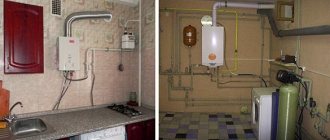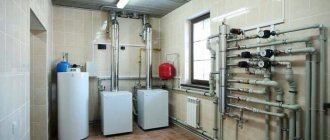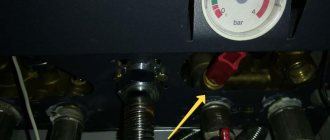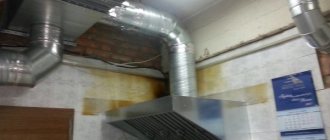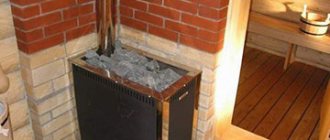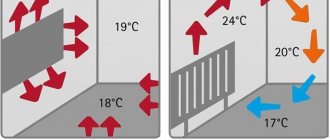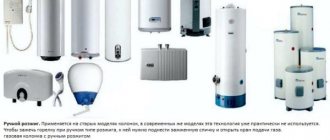General classification of gas burners by fuel type
Country houses cannot always be supplied with natural gas supplied from a public main.
Therefore, the burners are varied in terms of using different types of fuel. If the fuel comes from the gas main, propane-butane gas burners are most likely used for heating boilers. Trunk methane gas is the most affordable natural fuel for boilers. However, now there is no big benefit in the price of liquefied blue fuel (propane-butane mixture). General heating provided by the main pipeline is also expensive.
Gas boilers operating on different types of fuel mixtures have approximately the same design. There is a slight difference in cost, but it is also insignificant (equipment for liquefied fuel will cost more). The burners themselves are slightly different, having different nozzles for liquid fuel and blue gas.
If natural gas is not supplied to the house, propane-butane gas burners are used
Propane burners require adjustment to this type of fuel with the installation of a nozzle. When burning, the flames give off a yellowish color, and more soot accumulates in the chimney. The jet is responsible for normalizing pressure.
Modern burners operate in a wide temperature range – from -50 to +50 °C. Some equipment can be adapted for other types of energy carriers:
- used oil;
- diesel fuel;
- fuel oil;
- kerosene;
- propane butane base;
- Arctic diesel fuel.
Modern devices often include both types of injectors or universal equipment for fuel types, making them easy to reconfigure.
Homemade gas burners are most often used in solid fuel boilers
It is safer to purchase simple gas equipment adapted for bottled gas. Homemade equipment, although more affordable, is unsafe! Usually, “reworks” are carried out on the basis of old units.
Turbocharged types of gas burners and their design differences
Among modern gas equipment, many experts prefer closed-type burners for turbocharged boilers. They are self-sufficient in design and require a compact chimney, which can even be diverted into general ventilation during autonomous heating.
A heating unit with a special closed-type combustion chamber receives oxygen from the outside - through a special supply pipe (coaxial chimney). Combustion products are removed approximately in the same way. The heating equipment is controlled by a fairly powerful automatic fan.
Fan gas burners also have a drawback - the price, due to the complex design of the product
Such a device is much more expensive than atmospheric heating equipment. However, for an additional fee, the buyer receives a number of advantages, including autonomous operation in a residential area. This device, thanks to automatic control, has a high level of safety.
Turbocharged equipment has the highest efficiency and flexible temperature scheme
The fuel burns almost completely, which is important for environmental performance. There are also disadvantages, including design complexity, which causes difficulties during installation and repair
Gas burners for combined equipment are most often used in solid fuel boilers. This is a rather complex unit, so all components must meet certain efficiency and safety requirements. The automatic device is capable of switching from one type of fuel to another for uninterrupted heat supply. Pellet and pyrolysis boilers are designed according to this principle, equipped with gas for burners that drives the ignition process.
Device
For complete combustion of natural gas and maximum heat transfer, it must be mixed with a certain amount of air with a normal oxygen content, which acts as an oxidizer. At the exit, the fuel mixture of gas and air should burn with a practically colorless flame with a bluish tint and a maximum temperature. By design, gas burners differ in the method of supplying gas and air, mixing components and the method of forming a flame torch.
In household heating boilers, mainly only two types of gas burners are used according to the method of preparing the fuel mixture:
- atmospheric;
- fan (inflatable).
In addition, there are diffusion, injection recuperative, regenerative burners, with preliminary full or partial mixing, but they are in demand mainly in industrial boilers and process equipment. Atmospheric and inflatable types are often improved using certain aspects characteristic of other types of structures, but the principle of operation remains the same.
The type of burner determines the requirements for the design of the combustion chamber, heat exchanger, operational characteristics of the boiler and the method of removing waste gases and exhaust. The last parameter is key for choosing a boiler. For atmospheric burners, a chimney is required to maintain natural draft. For inflatable ones, it is enough to take a special coaxial chimney outside the room.
For heating boilers, it is important to control not only the combustion process as such, but also the output thermal power, because the goal is to heat the coolant and maintain a constant set temperature. This is how the main operational characteristic is determined - the method of power control:
- single stage;
- two-stage;
- with smooth flame adjustment;
- modulation.
Riello single-stage burner
In the first case, the gas burner operates only in one mode of complete combustion of all incoming gas. The main advantage is the simple design and, accordingly, low cost of equipment. However, it is necessary to constantly turn the gas supply on and off in order to maintain the required coolant temperature. The output results in three significant disadvantages: increased gas consumption, strong fluctuations in the temperature of the coolant in the boiler, and a decrease in service life due to frequent switching on/off.
Gas burner device for a boiler
Atmospheric and fan burner devices differ in their structure. This is due to the different ways in which oxygen is supplied to the chamber during fuel combustion.
Atmospheric burner device.
Air enters the combustion chamber directly from the room. Nozzles are located inside the burner channel. Gas is supplied to the nozzles, mixing with air, which also has access here. At a short distance from the nozzles there are outlet slots through which the finished fuel mixture is supplied. An area of reduced pressure is created between the nozzles and outlets, which promotes a constant supply of air for mixing.
A pilot burner is constantly running in the combustion chamber to ignite the main device.
Fan burner device.
The device block consists of:
- engine;
- fan;
- automatic control unit;
- gearbox;
- air pressure switch;
- fuel mixer.
Air is forced from outside by a fan and supplied to the combustion chamber to form a fuel substance. The air to gas ratio can be adjusted using a damper and a fan.
How to set up a gas burner?
It is recommended to adjust the gas boiler burner flame using a gas analyzer. It records indicators of the air that participates in the process of fuel combustion: CO concentration, oxygen level, excess air ratio. The CO concentration should not exceed 50 ppm; oxygen is normally in the range of 3.6-5.3%. A lower oxygen content will lead to incomplete combustion of the fuel, a higher oxygen content will lead to a high concentration of CO2. Excess air can lead to an explosive situation, and its lack can lead to incomplete combustion of fuel, the formation of soot, soot and low efficiency.
The intensity of the fire can be observed through the viewing hole. The orange flame is too large, you can reduce it until it becomes almost invisible and has a bluish tint. Such a fire ensures optimal operation of the gas boiler. If you reduce the flame further, it will become completely invisible and then go out.
Setting the gas burner flame
In order to properly configure the burner of a gas boiler, you must first follow the operating instructions for the gas appliance. Next, we’ll talk about how to properly start and set up a gas burner, and in what cases flame adjustment is necessary. But first things first.
Features of boiler burner settings
It is recommended to adjust the burner flame using a gas analyzer. It shows information about the amount of air that is mixed with the gas, namely the level of oxygen involved in the process and the amount of CO.
Typically, CO should be no more than 50 ppm, oxygen concentration should be approximately 3 to 5%. If it is less, then most likely the gas will not have time to burn, as a result of which a lot of soot will accumulate, the CO2 level will be higher than normal, and the efficiency of the equipment will decrease.
If the air is more than normal, then the temperature of the household burner of the gas boiler will be too high, and this can lead to tragic consequences, including an explosion of the equipment.
The flame in the gas burner should be blue. If you find that the color has an orange tint, then try reducing the amount of gas. Reduce until the color turns blue (blue). This color is a sign of optimal operation of the gas appliance. The main thing is not to reduce the fuel supply to the point where the flame becomes almost colorless. In this case, it will go out very quickly.
Setting the starting gas supply is only necessary during ignition and does not affect the performance of the device. But if necessary, it is possible to adjust it too. To begin with, you should reduce the starting fuel supply. Reduce until the burner stops turning on. After this, you can turn the regulator until ignition resumes. You can watch the video at the end of this article for more details on setting the flame of a household gas burner.
We also recommend that you familiarize yourself with the intricacies of adjusting a gas boiler.
When is flame adjustment necessary?
An atmospheric gas burner, which operates without a built-in fan, very often fails; a turbocharged one breaks down much less often. During prolonged use of the device, its components may break or stop working at full capacity.
For example, a gas boiler may experience reduced efficiency or a decrease in flame.
And this can happen for the following reasons:
- High burner power installed for equipment that is designed for less powerful burners. In this case, there is not enough space for proper combustion of fuel, the fuel burns unevenly, which leads to soot quickly accumulating on equipment parts.
- A lot of soot in the chimney can have a bad effect on the draft of a gas boiler. Because of this, the subsequent removal of combustion products is very weak, little air enters, and the flame becomes yellow.
- The presence of burner defects is one of the reasons for reduced boiler efficiency, but in this case, adjusting the flame will not help correct the problem.
- Pressure drops when supplying gas can also contribute to the formation of soot and carbon deposits, and this will significantly reduce the productivity of the equipment.
All these reasons can affect the flame temperature in the gas burner, in which case repairs will be required.
Which gas burner to choose for heating
Factory-built gas stoves for a home or cottage are largely similar in design. Almost all of them have a combustion chamber (or heat exchanger), a housing/casing, a smoke removal system, exhaust planes/openings/holes for hot air, and automation. But there is a key element that is used in one form or another in all devices.
Purpose of the device
The burner is the heart of any gas heating unit, on which efficiency, heat generator power, efficiency, safety, and overall functionality depend. It is in it that the gaseous fuel is mixed with oxygen, and it also houses the automation and main control mechanisms that ensure stable combustion in various modes. The same burner models, in principle, can be used in both boilers and furnaces.
The single-stage atmospheric burner is easy to operate, it fits well with the heating panel, and does not need to be connected to the electrical network.
The gas burner is installed in the stove from the front side, approximately in the place where the firebox door is usually located in wood-burning stoves. An important technical indicator of burners is the rated power (indicated in kW), which primarily depends on the ability of a particular burner model to burn a given amount of gas in a certain time.
Types of gas burners for furnaces
According to the type of burner thermal power control, there are:
- single-stage (automation turns the fuel supply on or off);
- two-stage (the heating device can switch to economical heating mode, for example, from 100% to 40%);
- floating adjustment (power changes smoothly - within 10-100%).
According to the type of air supply, gas burners for furnaces are divided into:
- atmospheric (air is sucked in by gravity under the influence of draft, there is no connection to electricity, efficiency is no more than 90%);
- supercharged (the fan supplies air when the chamber is closed, there is a dependence on the power supply, efficiency is above 95%).
Note! In stone heat-intensive devices (especially with high power), or if you make a gas melting furnace with your own hands, the burner may overheat, so it is necessary to use models of the high-temperature resistant “NT” type. Based on the type of ignition, burners are divided into products equipped with:. Based on the type of ignition, burners are divided into products equipped with:
Based on the type of ignition, burners are divided into products equipped with:
- electronic ignition (there is no constantly burning igniter, dependent on electricity);
- piezo ignition (no connection to the electrical network).
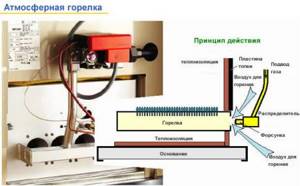
An atmospheric burner operates on this principle.
Also, in order for the body of a heating device (for example, for a bath) to warm up evenly, you need burners that distribute the flame better. As a way out, various torch dividers or distribution tubes are used (as in a conventional kitchen oven).
Gas heating will be efficient and safe only if all technical requirements are met during the development and installation of the system. This is a rare case when you can’t do without specialists in your field.
Gas burners can be atmospheric or forced. The first ones are simpler in design, the second ones have a greater degree of functionality.
use and useful video on the topic
We recommend watching a video on how to set up a gas flame. The burner video talks about the main problems of a gas burner when adjusting the flame is required.
next Watch a video that details the main reasons why your gas burner is not working properly or has stopped lighting altogether. The most common reason is the accumulation of large amounts of soot, which is formed from incomplete combustion gas:
Try to use your own equipment correctly if the start-up of the gas boiler burner occurs when interruptions occur, which means you need to urgently perform diagnostics and find out the cause of the interruptions, otherwise the device may harm your property, life or.
It is also worth remembering about the storage and transportation of gas burners. To do this, you need to study the operating rules that are written in the documentation. Such documents should be included in the equipment purchase kit. In any case, if you find out any malfunctions, urgently contact a reliable gas service or specialists who will help you resolve the current situation.
Would you like to supplement the information presented above with useful information on the topic of the article? Would you like to share your own experience of setting up a household gas burner with other users? Write your comments, share your experience, participate in the discussion - the feedback form is located below.
flame Setting the gas burner
In order to properly set up the burner of a gas boiler, you must first of all follow the operating instructions for the gas appliance. Let's talk further about how to properly start and set up a gas burner, and in what cases flame adjustment is necessary. But first things first.
Features of the boiler settings burner
It is recommended to adjust the flame using a burner gas analyzer. It shows information about the amount of air mixed with gas, namely the level of oxygen involved in the process, and the amount of CO.
As a rule, CO should be no more than 50 ppm, oxygen concentration should be approximately 3 to 5%. If it is less, then most likely the gas will not have time to burn, as a result of which a lot of soot will accumulate, the CO2 level will be higher than the efficiency, and equipment standards will decrease.
If there is more air than normal, then the temperature of the household gas burner of the boiler will be too high, and this can lead to tragic consequences, including an explosion.

To ensure maximum equipment performance, ensure that the gas burner flame is blue. If it is yellow, blue or orange, it means that it is necessary to do the opposite; in this case, the gas will burn without leaving a lot of soot. This in turn will lead to damage to the device.
The flame in the gas burner should be blue. If you find that the color has an orange tint, try it, which means reducing the amount of gas. Reduce until the color becomes blue (color). This color is a sign of optimal gas operation of the device. The main thing is not to reduce the fuel supply until the moment when the flame becomes almost colorless. In this case, it will go out very quickly.
Setting the starting gas supply is only necessary during ignition and does not affect the performance of the device. But depending on the need, it is possible to adjust For. its beginning, the starting fuel supply should be reduced. Reduce until the burner stops turning on. After this, you can turn the regulator until the ignition is no more. will resume in detail about setting the flame of a household gas burner, you can watch in the video at the end of this article.
We also recommend that you familiarize yourself with the intricacies of gas boiler adjustment.
When adjustment is necessary Gas
flame? An atmospheric burner, which does not have a built-in fan, very often fails; a turbocharged burner breaks down much less often. During long-term operation of the device, its components may break or stop working at full capacity.
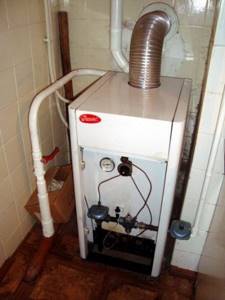
A floor-standing gas boiler takes up useful space in your room, so such heating systems are suitable for private homes more often. In all houses, a special room is allocated for such devices - a boiler room, in which wall-mounted units are installed. boiler boilers save space, so they are installed preferably in apartments or houses with small For example
area, the efficiency indicators of a gas boiler may decrease or a decrease may be observed.
And the flame may occur for the following reasons:
- power Large burner installed for equipment intended for less powerful burners. In this case, there is not enough space for proper combustion of fuel, the fuel burns unevenly, which leads to soot quickly accumulating on equipment parts.
- A lot of soot in the chimney can have a bad effect on the draft of a gas boiler. Because of this, the output of subsequent combustion products is very weak, little air enters, and the flame becomes yellow.
- The color of the burner defects is one of the reasons for the efficiency of the boiler, but in this case, the adjustment will help the flame not to correct the problem.
- Gas supply pressure differences can also contribute to the formation of soot and deposits, and this will significantly reduce equipment productivity.
All these reasons can affect the temperature of the flame in the gas burner, in which case repairs will be required.

Wall-mounted heating boilers and gas water heaters are installed, most often, in apartment buildings. But at home they may need to adjust the flame. Recommendations
Rules and technology for using a gas burner
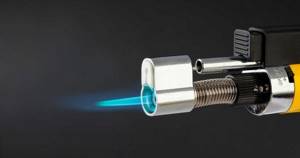
- Design features of the burner
- How to light it?
- How to use?
- Safety precautions
Natural and liquefied gas burners are becoming more common. Therefore, knowing the rules and technology for using a gas burner is very important. There are subtleties in both the ignition process and the observance of safety precautions.

In what cases is it necessary to adjust the burner flame?
An atmospheric gas burner for heating equipment often fails. It is equipped with models of both wall-mounted and floor-standing boilers. The injection burner of floor-standing equipment reduces its efficiency for various reasons:
- Burner power is too high. This happens when a high-power burner is purchased for small heating equipment. At the same time, there is not enough space for combustion, the air flow for such power is weak, which leads to the transition of the flame from blue to yellow, sooting of the combustion chamber and chimney.
- If the chimney is poorly cleaned, the boiler draft deteriorates. At the same time, waste combustion products are poorly removed, and the air flow is small. This worsens combustion and the flame turns yellow.
- A defect in the burner itself does not make it possible to correctly adjust the complete combustion of the fuel.
- Due to pressure changes in the gas supply system, well-regulated equipment can release large amounts of unexhausted gas into the chimney. Partially it settles with soot and soot. A large layer of soot reduces traction and increases fuel consumption.
- Starting heating equipment after repair.
- The presence of extraneous noise during operation of the boiler or gas burner.
- Changing the type of fuel.
Selection of burners for different types and models of boilers
When choosing a burner, you should pay attention to its various characteristics - the fuel supply model, the option of mixing gas with air, compatibility with various categories of devices. We will tell you about the most interesting models
KChM burner. It is used in boiler units converted from conventional fuel to LNG or conventional gas. It usually has automation and has three nozzles. It is used in boiler units of the “Contour” model or similar options.

- Burner "Hearth". It is a pneumomechanical type device with an automatic operating mode. It turns off on its own if:
- the fire went out;
- gas supply stopped;
- there is no necessary traction.
This model has a gas pressure controller. This makes it possible to achieve equal burning of the fire, even if any malfunction occurs in the mechanism. Such solutions are easy to maintain due to the fact that soot does not accumulate in the convective part.

- Another burner that I would like to talk about is the “Kupper” model. This option is universal and is suitable for combined boilers, solid fuel designs from Kiturami or Russian-made models of the Conord brand. The advantage of this burner will also be the ability to install it without plumbing or welding.
- Another fairly popular solution is the DKVR burner. This block device is used where there is forced air supply. This solution is used for steam boilers for industrial use and having the appropriate power. Their efficiency is about 94-95 percent. A similar design works either in a diffusion or in an inflatable version. To increase its efficiency, powerful Italian fans are often used.

Another category is burners for KVS. They are used for domestic needs and are solid fuel. Considering that there is no need to use overly powerful equipment to heat rooms, atmospheric or injection solutions are used
When selecting a burner element, you should pay attention to power and safety in use

Converting the burner to another type of gas
Only universal burner devices can be easily adapted to another type of fuel and do not require replacement of component parts. To switch to a different type of gas, the remaining burners need to replace the ramp, diaphragm, nozzles or manifold. Using the ramp, you can regulate the gas supply over a fairly wide range. In some cases, it is possible to adjust a burner operating on one type of fuel to burn on another type of gas. For example, switch from propane to methane and vice versa. When replacing propane with methane, the starting flow is first increased to ignite the gas, and then gradually reduced, as detailed in the previous section.
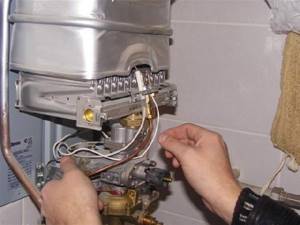
When switching to propane during initial startup with maximum fuel supply, a methane burner will smoke. It is adjusted by gradually reducing the fuel supply.
When converting a burner device from one type of fuel to another, it should be taken into account that the specific heat of combustion of propane is 1.5 times greater than that of natural gas - methane. So the power of a methane burner running on propane without replacing elements will increase. For example, a gas boiler with a power of 10-30 kW, when converted to propane, is capable of delivering a performance of 15-45 kW. However, the burner will not be able to produce more than 30 kW for a long time, as it will quickly overheat and fail. Therefore, the operating power range of the unit will be 15-30 kW.
When converting a similar boiler from propane to methane, the power will decrease and amount to 6 -18 kW.
Private construction is gaining momentum, and with it the demand for modern heating equipment , uninterruptedly providing consumers with thermal energy for heating the house and heating water for household needs.
A gas boiler is the central link of a gas heating system created for such purposes. Being one of the most economical devices, it nevertheless needs to be properly configured to ensure proper fuel consumption and reliable operation.
OCCUPATIONAL SAFETY REQUIREMENTS BEFORE STARTING WORK
2.1. Before starting work, you should put in order and put on overalls, safety shoes, and, if necessary, check the availability and prepare other personal protective equipment. Overalls must be of the appropriate size, clean and not restrict movement. 2.2. Before work, you need to select the tools and technological equipment necessary to complete the work, check their serviceability, tools and materials must be located in a convenient place, taking into account the technological sequence of their use. 2.3. When preparing a gas cylinder for operation, it is necessary to remove the steel cap and plug from the valve using a non-ferrous metal wrench, inspect the fittings, if necessary, remove dirt and blow out the valve by quickly turning the flywheel (open-close). 2.4. If the cap cannot be removed, the cylinder is considered faulty and must be sent to a warehouse. 2.5. Before starting work, it is necessary to check the gas burner, since a clogged nozzle can cause an intermittent flame, “backfire”, or gas leakage at the connections of the hoses to the burner and to the cylinder. 2.6. All tools and devices for performing work must be in good condition; Defects discovered during the inspection must be eliminated; if it is impossible to eliminate the defects on your own, no work can be done. 2.7. Before starting work, it is necessary to carefully inspect the work site, put it in order, remove all foreign objects and, if necessary, install protective barriers. 2.8. You should not start work in case of the following violations of safety requirements: - in case of malfunctions of the tools used, technological equipment, or protective equipment for workers; — in case of insufficient illumination of the workplace and approaches to it. 2.9. The employee must personally ensure that all measures necessary to ensure safety are completed. 2.10. An employee should not start work if he has doubts about ensuring safety when performing the upcoming work.
Adjusting the power of a gas boiler
In this case, the task is to reduce or increase the indicator. The indirect method of adjustment involves reducing the supply through the taps: the one located after the supply to the boiler and the one on the downstream side. The range of regulation will decrease, so it is better to prefer direct methods.
To increase power, select an option:
- Adjust the burner to the desired level - relevant for modulating units.
- Buy a more efficient burner.
- Replace the injectors with larger ones. Remember, with an increase in heat transfer from the boiler, gas consumption will increase, the risk of breakdown ahead of schedule, and the efficiency will decrease.
Ideally, it is better to entrust the adjustment to increase power to a boiler specialist. The increase in power for these options reaches 15%. If this is not enough, use additional devices to heat the rooms. Remember to clean the boiler to maintain power levels.
Tubes with micro-torches for an atmospheric burner - such a device operates almost silently, but is characterized by low power, dries out the air in the room and depends on a large number of external factors
Sometimes you have to reduce power. First, it is adjusted through the menu: by parameters of the heat exchanger temperature and anti-cycling time. Then set up the circulation pump. If necessary, change the burner to a modulating one.
Reasons for changing boiler power:
- Increase: it is necessary to re-equip the device at the same time as increasing the power, connect an indirect heating boiler, the heating area has increased.
- Reduction: refusal of one of the functions (heating or hot water supply), part of the functionality (heating of individual rooms, heated floors), reduction in boiler performance.
If there is excessive fuel consumption, it is worth inspecting the secondary heat exchanger and removing residual salts manually or with a chemical compound. Contamination will be indicated by a characteristic gurgling sound when the boiler is operating.
Consumption increases due to the low specific heat of combustion (calorific value) of the gas. The norm is no less than 7,600 kcal m³. Poorly dried fuel's calorific value drops by almost half.
Also adjust the gas valve. They are regulated depending on the structure:
- single-stage ones have only “on” and “off” positions;
- two-stage valves are equipped with 1 inlet and 2 outlets, and they open in an intermediate position;
- three-stage boilers have two power levels;
- With the help of modeling valves, power can be adjusted more smoothly; they have many flame modes, in addition to the “on” and “off” positions.
Look at the color of the flame. If there is a noticeable yellow part, tighten the lower valve to reduce the fuel supply.
845 SIGMA Multi-Function Gas Valve with Power Modulation, Outlet Pressure Regulator and Fuel Control Module - Accommodates a variety of threads and flanges
Set the heating operating temperature on the thermostat again. The principle of its operation is that the rod is turned on. As the temperature drops, the element shrinks and opens the fuel supply. An increase in temperature leads to an increase in the rod, causing gas to flow in a smaller volume.
If there is a lack of air, inspect the damper, boost and temperature regulator. A popping sound when igniting the main burner appears due to clogged air supply paths. Remove dust from them and inlet openings.
How to increase the efficiency of a gas boiler
At the beginning of this article, it was already noted that the service instructions for the Protherm Gepard 23 MTV boiler indicate its efficiency in heating mode: 93.2% at maximum thermal power (23.3 kW) and 79.4% when operating at minimum power (8 .5 kW.) Imagine how the efficiency will further decrease if this boiler has to work with a heating system with a power of 4 kW.
At least 1/4 of the spent gas will literally fly uselessly down the pipe. This will be the price to pay for installing cheap heating and hot water equipment in your home.
The efficiency of “turbo” gas boilers, with forced air supply to the burner and removal of flue gases, is especially greatly reduced. This is due to the fact that the boiler fan operates at a constant speed, ensuring the movement of gases in the quantities necessary for the boiler to operate at maximum power. As a result, excess air and smoke are supplied and removed into the boiler, which operates at lower power. And with excess air and smoke, heat, gas, and money literally fly down the chimney.
In more expensive models of “turbo” gas boilers, the fan rotation speed is adjusted automatically, depending on the amount of power with which the boiler is currently operating. As a result, when the power decreases, the amount of air supplied for combustion decreases, which increases the efficiency of the boiler.
In order to reduce the amount of air supplied to the boiler burner by a fan operating at a constant speed, we proceed as follows.
Heater Maintenance
Maintenance of an infrared gas heater, like any other equipment, must be carried out at certain intervals. This will help avoid malfunctions during operation of the device.
A large layer of dirt increases thermal insulation, which significantly reduces the effect of heat waves transmitted by the heater into the space being treated. As a result, operating efficiency decreases, which negatively affects the functioning of the unit.
Manufacturers indicate the need and regularity of cleaning in the instructions for the device. This usually needs to be done once a year or as needed. In this case, be sure to turn off the device and wait until it cools down.
Placing the heater in close proximity to a wall may cause the device to overheat and melt plastic parts. Plastic covers heat sensors and causes disruption of thermoregulation. It is necessary to restore not only the housing, but also the sensor
Cleaning is carried out using a damp cloth, which must be soaked in soapy water. This way you can wash the heater body and the location of the cylinder with the gas mixture. Difficult stains can be removed using chemicals and brushes.
Compressed air is usually used to clean the inside of the heater whenever possible. A stream of air should be passed over the surfaces of the burner and ceramic plates until completely clean. The procedure must be carried out carefully so as not to damage the fragile structure of the ceramic parts.
The spark gap and burner openings are also cleaned using compressed air.
After cleaning the device, you need to wipe it dry. The burner and spark gap area must be dry before starting.
It is unacceptable to clean using an abrasive method. Blasting can cause serious damage to the finish of the equipment, resulting in malfunctions
Before reusing the heater again, you need to check the equipment connections for leaks. All connections of the pipeline supplying gas to the device and gas hoses are checked using a soap solution.
If a leak is detected, the device must not be started. Before starting, you must ensure that the leak has been repaired.
Carrying out preventive cleaning of the device and its inspection will help to significantly extend its service life.
Homemade units
There are craftsmen who remake heating systems with their own hands. On the Internet you can even find the necessary diagrams for changing the devices of gas burners, their installation and adjustment.
Typically, metal is used as a material for the manufacture of heating systems. A cast iron firebox would be much more reliable. However, it is not possible to use it at home.
An excellent option for manual work is to order the system from specialists. They will be able to manufacture the device in accordance with all the customer’s wishes. However, the possibility of defects in the boilers cannot be ruled out, which may appear after some time.
Why do you need homemade heating units? The fact is that the marked options have a lower cost. They are made mainly because of the desire to save money. At the same time, these options are inferior to their factory counterparts in efficiency.
Usually only solid fuel and electric units are manufactured. Making a gas or diesel boiler is extremely dangerous. In addition, their installation in the house is strictly prohibited.
According to the principle of operation, a homemade product is no different from a purchased version. It will burn fuel and heat the coolant filled with water.
The main disadvantage of this unit is the lack of warranty. Factory equipment will work and perform its functions. Even if the buyer stumbles upon a defect, he will be able to exchange the product for another.
It is better to use pellets, firewood, and coal as fuel in self-made units. These materials are less dangerous than gas. It is impossible to make heating devices based on the latter.
Simple solid fuel units are the most popular and widespread homemade devices. They are simple, and their design is in many ways similar to a conventional stove. In addition, they are versatile.
Like a conventional stove, these systems can operate on any solid fuel. The main thing is that it burns.
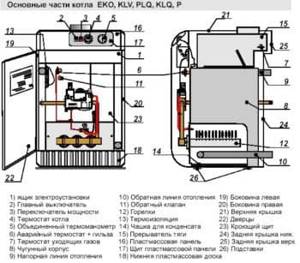
Main parts of a gas boiler.
The efficiency of homemade equipment is significantly lower than factory equipment. It is influenced by many factors.
Among them:
- thermal insulation;
- combustion completeness;
- the correctness of the conclusions.
The efficiency of the unit directly depends on the combustion temperature. The higher it is, the lower the efficiency. In high-quality systems, the temperature in the firebox is maintained at 120–150°C. Higher values reduce the safety of pipes. This in turn significantly reduces the durability of the unit.
When manufacturing heating boilers with a burner, it is better to protect yourself as much as possible from the possible consequences of its operation. Therefore, you should consider a separate purchase of an automatic gas burner, which will be installed in an atmospheric or blown boiler.
You can also make electric heating units with your own hands. Their design may vary. It all depends on the person’s needs. The simplest option is to install a heating element directly into the heating system. In this case, there is no need to make a boiler.
The pipe with the heater must have a sufficiently large diameter. It should be easily removable for repairs and cleaning.
Systems without a heater deserve special attention. Its role is played by water itself. A current is passed through it, and heating occurs due to the movement of water ions. The liquid itself must contain salt.
It is extremely difficult to make such a device. Electric current passes directly through the coolant, so the entire system must be reliably insulated.
One of the dangers of this device is electrical breakdown. Essentially the same as a short circuit. Gas may also accumulate in the system. As a result, heating efficiency will decrease.
From all of the above, the best option is a solid fuel unit. Its body can be assembled from heat-resistant steel. It is characterized by increased strength, less wear and high resistance to thermal influences.
However, heat-resistant steel is expensive and in practice is rarely used in homemade boilers. Another option is cast iron: this material tolerates heat well, although it is difficult to work with. Equipment for the manufacture of cast iron stoves is available only at specialized enterprises.
It is important to understand that without the proper experience and skills, it is better not to make a heating system yourself. Safety must come first
It is enough to make even one inaccuracy, and this can lead to disastrous consequences.
